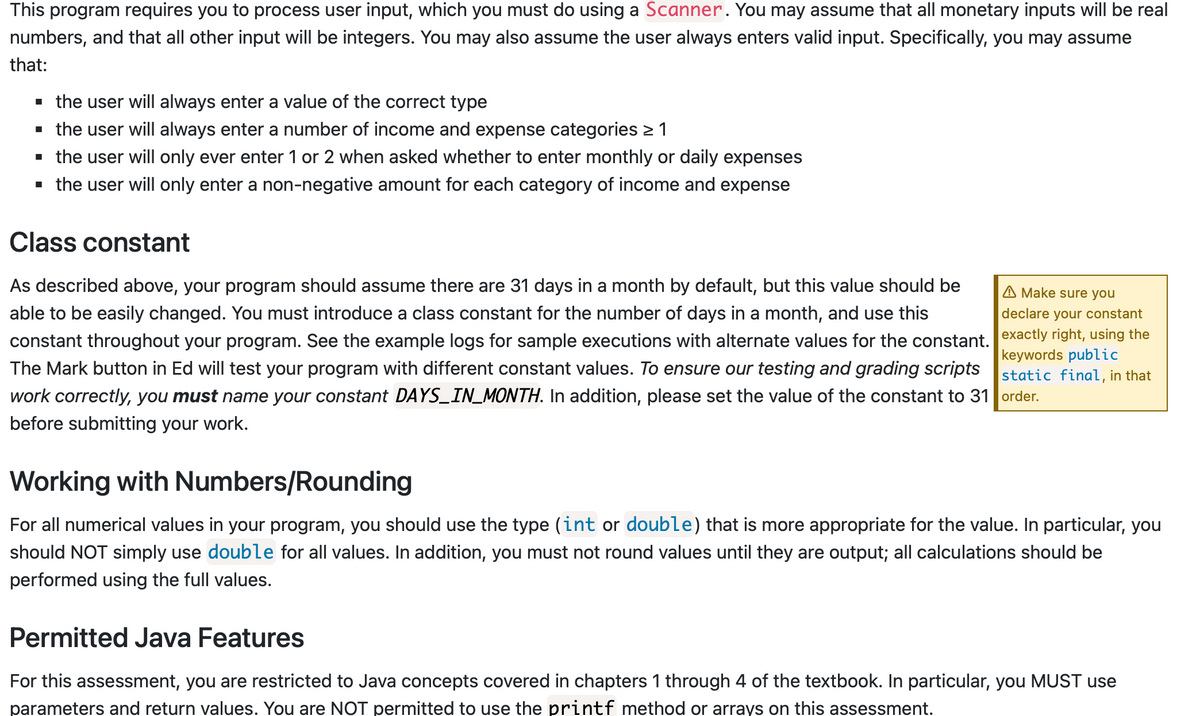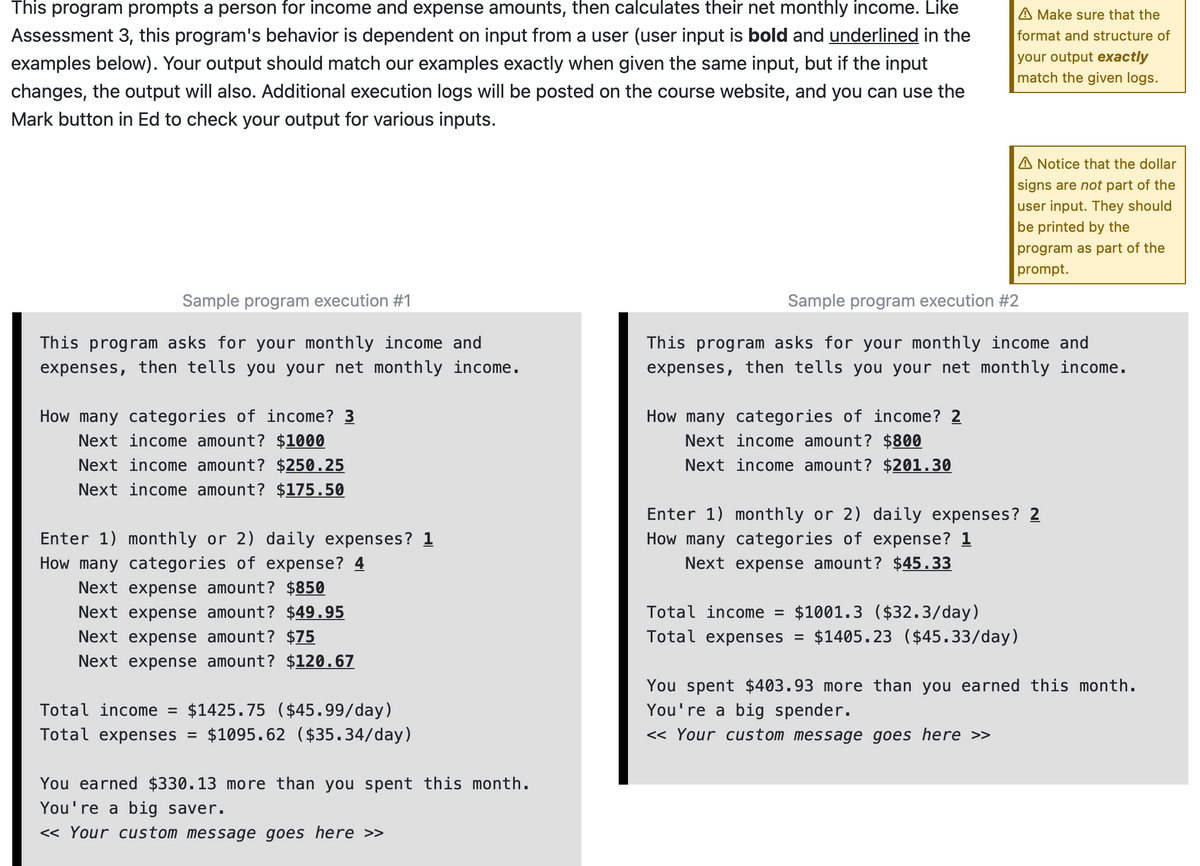me. Like This program prompts a person for come and expense amounts, then calculates their net monthly Assessment 3, this program's behavior is dependent on input from a user (user input is bold and underlined in the examples below). Your output should match our examples exactly when given the same input, but if the input changes, the output will also. Additional execution logs will be posted on the course website, and you can use the Mark button in Ed to check your output for various inputs. Sample program execution #1 This program asks for your monthly income and expenses, then tells you your net monthly income. How many categories of income? 3 Next income amount? $1000 Next income amount? $250.25 Next income amount? $175.50 Enter 1) monthly or 2) daily expenses? 1 How many categories of expense? 4 Next expense amount? $850 Next expense amount? $49.95 Next expense amount? $75 Next expense amount? $120.67 Total income = $1425.75 ($45.99/day) Total expenses = $1095.62 ($35.34/day) You earned $330.13 more than you spent this month. You're a big saver. << Your custom message goes here >> A Make sure that the format and structure of your output exactly match the given logs. How many categories of income? 2 Next income amount? $800 Next income amount? $201.30 A Notice that the dollar signs are not part of the user input. They should be printed by the program as part of the prompt. Sample program execution #2 This program asks for your monthly income and expenses, then tells you your net monthly income. Enter 1) monthly or 2) daily expenses? 2 How many categories of expense? 1 Next expense amount? $45.33 Total income = $1001.3 ($32.3/day) Total expenses = $1405.23 ($45.33/day) You spent $403.93 more than you earned this month. You're a big spender. << Your custom message goes here >>
me. Like This program prompts a person for come and expense amounts, then calculates their net monthly Assessment 3, this program's behavior is dependent on input from a user (user input is bold and underlined in the examples below). Your output should match our examples exactly when given the same input, but if the input changes, the output will also. Additional execution logs will be posted on the course website, and you can use the Mark button in Ed to check your output for various inputs. Sample program execution #1 This program asks for your monthly income and expenses, then tells you your net monthly income. How many categories of income? 3 Next income amount? $1000 Next income amount? $250.25 Next income amount? $175.50 Enter 1) monthly or 2) daily expenses? 1 How many categories of expense? 4 Next expense amount? $850 Next expense amount? $49.95 Next expense amount? $75 Next expense amount? $120.67 Total income = $1425.75 ($45.99/day) Total expenses = $1095.62 ($35.34/day) You earned $330.13 more than you spent this month. You're a big saver. << Your custom message goes here >> A Make sure that the format and structure of your output exactly match the given logs. How many categories of income? 2 Next income amount? $800 Next income amount? $201.30 A Notice that the dollar signs are not part of the user input. They should be printed by the program as part of the prompt. Sample program execution #2 This program asks for your monthly income and expenses, then tells you your net monthly income. Enter 1) monthly or 2) daily expenses? 2 How many categories of expense? 1 Next expense amount? $45.33 Total income = $1001.3 ($32.3/day) Total expenses = $1405.23 ($45.33/day) You spent $403.93 more than you earned this month. You're a big spender. << Your custom message goes here >>
Chapter5: Looping
Section: Chapter Questions
Problem 14E: In Chapter 4, you created a program that generates a random number, allows a user to guess it, and...
Related questions
Question
Whole to do in a while place This assignment will assess your mastery of the following objectives:
- Write a functionally correct Java
program to produce specified console output. - Use conditional (if) statements to conditionally excecute code.
- Write and call methods that accept parameters and return values to manage information flow.
- Use Scanner to accept .

Transcribed Image Text:This program requires you to process user input, which you must do using a Scanner. You may assume that all monetary inputs will be real
numbers, and that all other input will be integers. You may also assume the user always enters valid input. Specifically, you may assume
that:
▪ the user will always enter a value of the correct type
▪ the user will always enter a number of income and expense categories > 1
▪ the user will only ever enter 1 or 2 when asked whether to enter monthly or daily expenses
▪ the user will only enter a non-negative amount for each category of income and expense
Class constant
As described above, your program should assume there are 31 days in a month by default, but this value should be
able to be easily changed. You must introduce a class constant for the number of days in a month, and use this
constant throughout your program. See the example logs for sample executions with alternate values for the constant.
The Mark button in Ed will test your program with different constant values. To ensure our testing and grading scripts
work correctly, you must name your constant DAYS_IN_MONTH. In addition, please set the value of the constant to 31 order.
before submitting your work.
A Make sure you
declare your constant.
exactly right, using the
keywords public
static final, in that
Working with Numbers/Rounding
For all numerical values in your program, you should use the type (int or double) that is more appropriate for the value. In particular, you
should NOT simply use double for all values. In addition, you must not round values until they are output; all calculations should be
performed using the full values.
Permitted Java Features
For this assessment, you are restricted to Java concepts covered in chapters 1 through 4 of the textbook. In particular, you MUST use
parameters and return values. You are NOT permitted to use the printf method or arrays on this assessment.

Transcribed Image Text:This program prompts a person for income and expense amounts, then calculates their net monthly income. Like
Assessment 3, this program's behavior is dependent on input from a user (user input is bold and underlined in the
examples below). Your output should match our examples exactly when given the same input, but if the input
changes, the output will also. Additional execution logs will be posted on the course website, and you can use the
Mark button in Ed to check your output for various inputs.
Sample program execution #1
This program asks for your monthly income and
expenses, then tells you your net monthly income.
How many categories of income? 3
Next income amount? $1000
Next income amount? $250.25
Next income amount? $175.50
Enter 1) monthly or 2) daily expenses? 1
How many categories of expense? 4
Next expense amount? $850
Next expense amount? $49.95
Next expense amount? $75
Next expense amount? $120.67
Total income = $1425.75 ($45.99/day)
Total expenses = $1095.62 ($35.34/day)
You earned $330.13 more than you spent this month.
You're a big saver.
<< Your custom message goes here >>
A Make sure that the
format and structure of
your output exactly
match the given logs.
How many categories of income? 2
Next income amount? $800
Next income amount? $201.30
A Notice that the dollar
signs are not part of the
user input. They should
be printed by the
program as part of the
prompt.
Sample program execution #2
This program asks for your monthly income and
expenses, then tells you your net monthly income.
Enter 1) monthly or 2) daily expenses? 2
How many categories of expense? 1
Next expense amount? $45.33
Total income = $1001.3 ($32.3/day)
Total expenses = $1405.23 ($45.33/day)
You spent $403.93 more than you earned this month.
You're a big spender.
<< Your custom message goes here >>
Expert Solution
This question has been solved!
Explore an expertly crafted, step-by-step solution for a thorough understanding of key concepts.
Step by step
Solved in 4 steps with 4 images

Knowledge Booster
Learn more about
Need a deep-dive on the concept behind this application? Look no further. Learn more about this topic, computer-science and related others by exploring similar questions and additional content below.Recommended textbooks for you

Microsoft Visual C#
Computer Science
ISBN:
9781337102100
Author:
Joyce, Farrell.
Publisher:
Cengage Learning,

Programming Logic & Design Comprehensive
Computer Science
ISBN:
9781337669405
Author:
FARRELL
Publisher:
Cengage

C++ for Engineers and Scientists
Computer Science
ISBN:
9781133187844
Author:
Bronson, Gary J.
Publisher:
Course Technology Ptr

Microsoft Visual C#
Computer Science
ISBN:
9781337102100
Author:
Joyce, Farrell.
Publisher:
Cengage Learning,

Programming Logic & Design Comprehensive
Computer Science
ISBN:
9781337669405
Author:
FARRELL
Publisher:
Cengage

C++ for Engineers and Scientists
Computer Science
ISBN:
9781133187844
Author:
Bronson, Gary J.
Publisher:
Course Technology Ptr